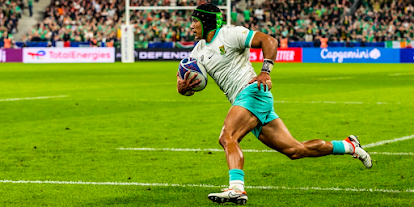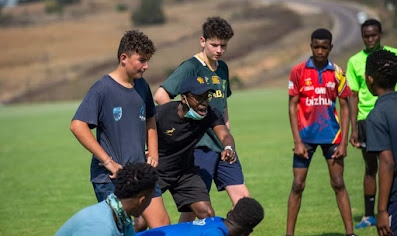Rugby World Cup 2023: Ireland and Springbok Attack Showdown
Ireland's approach to attack was characterized by their unwavering determination to capitalize on every phase of play. However, their tactical acumen was evident in their ability to discern when to kick the ball away, especially when the situation on the field became stagnant. Ireland's exceptional execution of skills played a pivotal role in keeping the momentum alive and allowing them to navigate through and around their opponents' defenses.
Conversely, the Springboks made a significant adjustment to their attack tactics by adopting a more ball-in-hand approach. They actively sought opportunities to offload in contact to maintain forward momentum and consistently looked to exploit the edges of the field. Similar to Ireland, the Springboks avoided forcing their attack when met with a resolute defense, opting instead to return possession to the opposition through strategic kicks.
In the upcoming analysis, we will closely examine the attack strategies employed by both teams during their match. Throughout this analysis, you will notice some intriguing similarities in their approaches, showcasing the tactical nuances that make rugby such a captivating sport.
Ireland attack: In the video clip below, you'll observe Ireland's attack approach. They opt for the front ball from the lineout. Subsequently, they launch an attack, starting with Gibson, who passes to Sexton. Sexton, in turn, releases Aki for a neutral carry right on the gainline. After this phase, they attempt to make progress around the corner, but they are unable to gain any ground from the carry. Recognizing the lack of forward momentum and gainline advancement, they make a pivotal decision to change the direction of their attack. Their attack strategy is layered, providing options to attack with the front line or orchestrate plays out the back. However, in this instance, they choose to execute a "tip-and-carry" play, opting for a hard, direct run. This decision is influenced by the Springbok defense effectively disrupting their passing lanes. As the realization sets in that the situation has become "stuffy" with no positive momentum or gainline advancement, Ireland wisely decides to kick the ball away, transitioning into a kick-chase contest. This sequence underscores the importance of patience and adaptability in rugby strategy. The key takeaway from this play is the astute recognition of the evolving dynamics on the field and the ability to adjust their tactics accordingly, illustrating the importance of patience as a fundamental element in their approach.
In the upcoming video clip below, Ireland finds themselves in a challenging scenario with an attacking scrum within their own 22-meter area. Typically, many teams would choose the conservative approach, setting up a phase from the ensuing ruck to secure possession and facilitate an exit from their defensive zone. However, Ireland opts for a more expansive strategy. They decide to spread the ball wide, while also keeping the option to kick in mind. In this instance, they choose to employ the kick option as a means to alleviate the mounting pressure. This strategic decision aligns with a recurring theme in Ireland's gameplay under the guidance of Andy Farrell. Under Farrell's coaching, Ireland has frequently incorporated run exits into their tactics. This approach serves a dual purpose: first, it manipulates the positioning of the opposition's backfield players, compelling them to commit more defenders to the front line. As a result, this strategic movement creates additional space in the backfield that attacking teams can exploit by executing well-placed kicks to pin their opponents in their half. In essence, Ireland's choice to use this kick option in their own 22-meter area is a testament to their commitment to tactical innovation and the exploitation of opportunities within the game. This decision reflects their understanding of how to control the dynamics of the match and create advantageous situations on the field.
Irelands try
In this particular clip below, we are given a glimpse of Ireland's diverse attacking strategy within the opponent's 22-meter area, initiated from a 5-man lineout. What stands out here is Ireland's proficiency in seamlessly transitioning between power plays involving their forwards, which we witness over several phases. During this sequence, Sexton makes a strategic decision to execute a wraparound play. Jesse's desperate tackle attempt stops him just as he reaches the try line. In the subsequent phase, we see Gibson Park taking charge from the base of the ruck, with Mahony effectively holding the defensive line. Lowe, displaying remarkable composure, deliberately slows down his feet and delivers a well-timed pass to Mack Hansen who ultimately scores the try. The opportunity for Irelands try came from them forcing the Boks to be narrow. This clip serves as a testament to Ireland's attack prowess. It illustrates their ability to launch powerful attacks, break through formidable defenses, employ wraparound tactics to narrow the opposition's defensive line, and ultimately find a path to the try line. It showcases the depth and versatility of Ireland's attacking playbook.
Springboks General Attack
In the following clip, the Springboks seamlessly transition into a general attack system. Notably, they initiate their strategy strategy off wide rucks, and from a statistical standpoint, they prefer playing off 9. The play unfolds with the ball being distributed to a pod of three players, who skillfully execute a pass out the back, directing the ball out to Snyman. What adds a promising dimension to the play is having players of Snyman's caliber who possess the ability to break the gainline and gain valuable meters. Upon receiving the ball, Snyman makes significant progress but is eventually tackled, leading to the formation of a ruck. Recognizing the identified space on the field, Faf delivers a pass to Libbok. Libbok, in turn, executes a miss pass with the objective of reaching the open space. The team continues to force passes, creating opportunities, and ultimately, the ball is directed out. This sequence is encouraging for multiple reasons. Firstly, it highlights the Springboks' commitment to playing with variety, showcasing a diverse range of strategies within their attack playbook. Secondly, the team displays a keen ability to identify and exploit open spaces on the field, emphasizing a strategic approach to their attack. Overall, this clip is a testament to the Springboks' adaptability and ingenuity in their general attacking play.
In their general attack and kicking strategy, the Springboks leverage the versatile skills of Damian Willemse. Positioned as a dynamic player maker in the attacking line, Willemse operates with the options of running, passing, or kicking. When the opportunity to kick arises, he seamlessly executes it on the run, directing the ball into strategic positions on the field, often referred to as "putting it on the foot into coffin." What makes Willemse's approach particularly noteworthy is his ability to kick while on the run. This aligns with the contemporary trend highlighted by rugby experts like Ronan O'Gara, who emphasizes the shift away from static kicking. Willemse's capability to execute precise kicks while in motion adds a dynamic and unpredictable dimension to the Springboks' attacking playbook. It becomes a valuable tool that enhances their overall offensive strategy and keeps the opposition on their toes.
Set piece Attack
In the following clip below, we observe the Springboks opting for an immediate attack towards the edges, both from a lineout and a scrum. In the earlier days under Rassie, the traditional Bok approach often involved setting up off the 12, forming a caterpillar ruck, and executing a box kick to initiate a kick-chase scenario. What stands out as impressive in this current approach is the deliberate departure from predictability in their set-piece attacks. Unlike the former strategy, the Springboks are now focused on removing the predictable element from their set-piece plays. Instead of adhering to a conventional pattern, they are dynamically shifting towards a strategy that prioritizes quick movement towards the edges, injecting an element of surprise and unpredictability into their attacking repertoire. This shift showcases the team's adaptability and evolution in their tactical approach, demonstrating a commitment to keeping opponents guessing and maintaining a strategic edge in their set-piece plays.
Springbok try
In the sequence leading to this try, several key players demonstrate exceptional execution under high-pressure circumstances to capitalize on the scoring opportunity. A mark of a proficient team is their ability to convert chances during the first phase of attack. The play unfolds with De Allende receiving the ball flat from Faf, inducing defenders to commit and creating a momentary hesitation. De Allende then distributes the ball out the back to Mannie, who, in turn, delivers a well-timed miss pass to Kolbe. With precision Kolbe seals the try.
Fingers crossed, we might witness another thrilling encounter between these two teams. Their recent performance showcased precisely why they are prime contenders to lift the Rugby World Cup trophy on the 28th of October. What stood out was their strategic intent—skillfully manipulating the game, seamlessly transitioning between power plays, exploring the edges, and displaying a knack for scoring from kick passes if that option comes up. The multi-threat nature of their attack puts immense pressure on opposing defenses. Both teams have proven their capability to score in diverse ways, adding an extra layer of unpredictability to their attack prowess. Their adaptability and proficiency in a variety of approaches make them formidable contenders, and it would be a treat for fans to witness another showdown between these two rugby powerhouses.
Katleho Lynch




Comments
Post a Comment